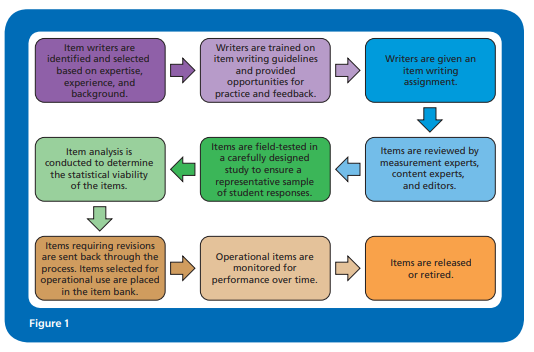
Test items (questions) are the backbone of every test. They are the manifestation of the content standards, meaning they are the bridge from what students know and can do in the classroom to the standardized evaluation of learning and growth. Much of the content validity of test scores rests squarely on the test items and their assembly into test forms.
The development of test items is a careful, meticulous process with safeguards along the way to ensure content accuracy, fairness, statistical integrity, and accessibility for students. Item development is a careful, multi-step process that begins once the test purpose has been defined, once a common understanding of the target domain exists, and once content and performance standards have been developed. Then it is possible to write items that measure the content standards.
During the design of the test, specifications are developed that outline the content that is to be assessed by the test. Item specifications are an important component of the process for the item writer. These specifications are the framework used by writers to create and develop the test items. Once the test specifications are developed, the item development process can begin.
Figure 1 below illustrates what happens during the life cycle of an item. This brief will describe the process and discuss each stage and how it relates to the content validity of test scores. Initially, item writers are selected who have the appropriate experience, expertise, and background to generate content for the test. The writers generally pass a rigorous selection process to ensure that the writers are familiar with both the content of the test and the group for whom the test is being written. Item writers must have an understanding of both the content and the examine population by possessing exceptional content knowledge, experience with the age group taking the test, and the ability to communicate ideas and content clearly

Next, item writers receive intensive training. This is another key way that content validity can be assured. The training must be robust and intensive in order to assure that the writers are able to communicate and write effectively. Item writers learn how to transition from content standards to questions that address the appropriate content and cognitive demand of the item. The spirit of the content standards is represented in the group of items selected for the test, so it is always important that there is a clear link from the items to the content standards. Once the item writers have been properly trained on best practices in item writing, they receive their item writing assignments. The allocation of item writing assignments is where the content coverage of a test begins to take shape. In order for a test to measure the content standards according to the cognitive and content demands outlined by the test specifications, careful assignments must be distributed.
To read about the remaining steps, download the full article!






.jpg)